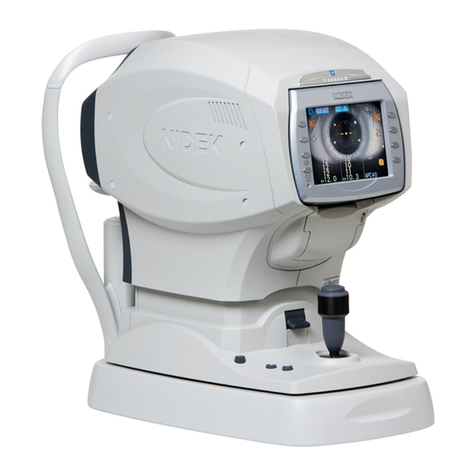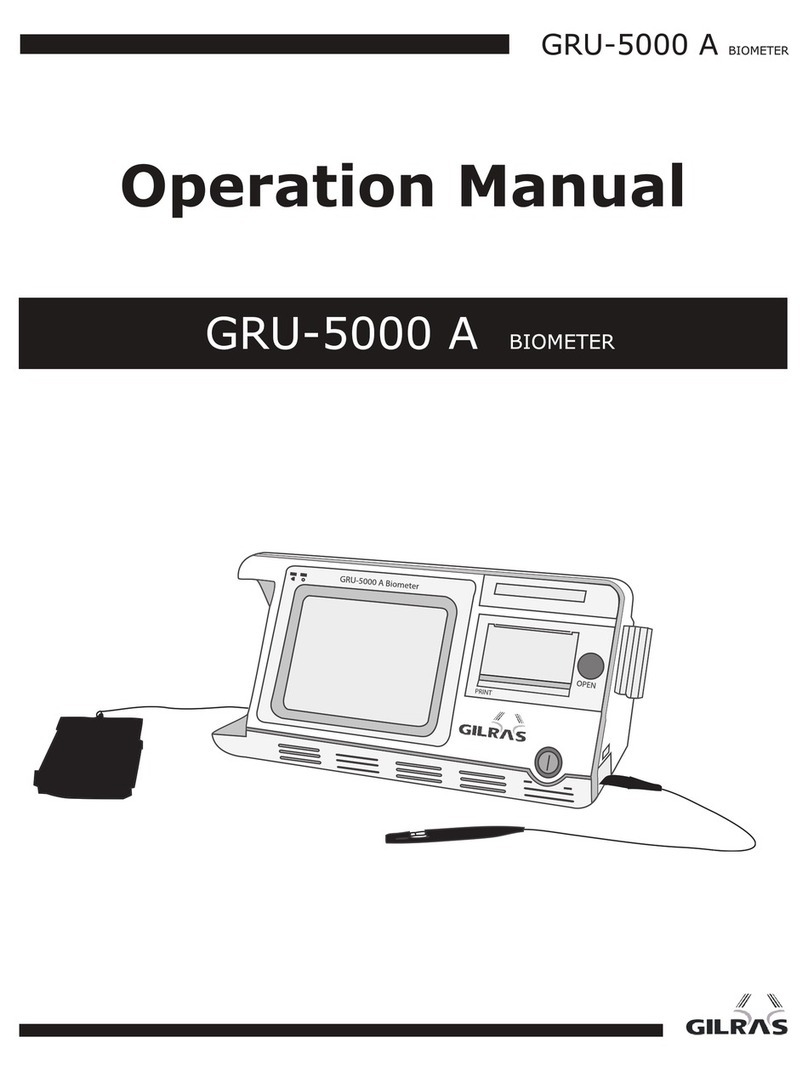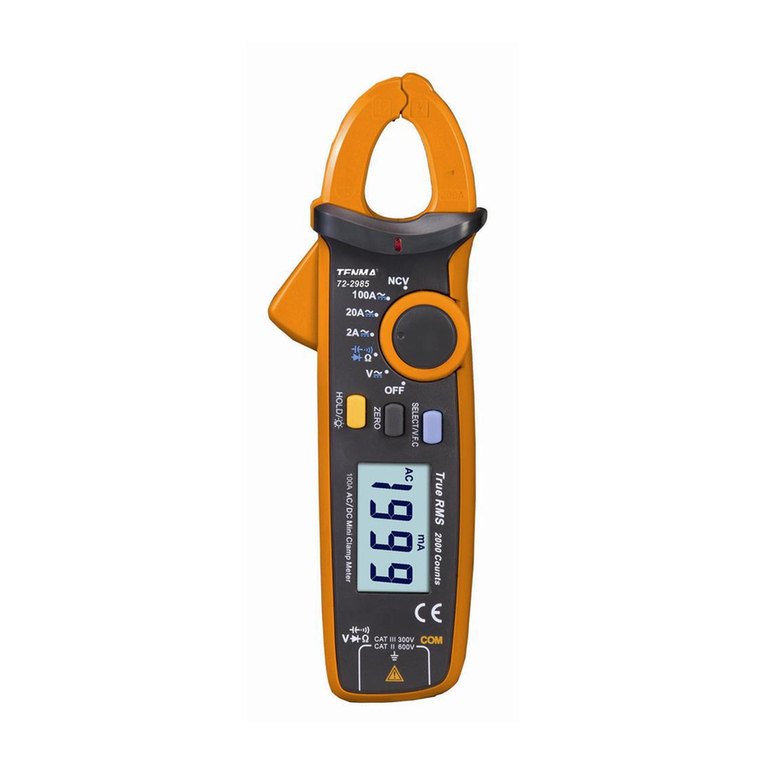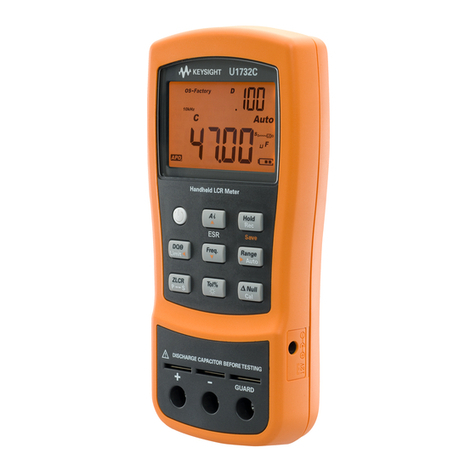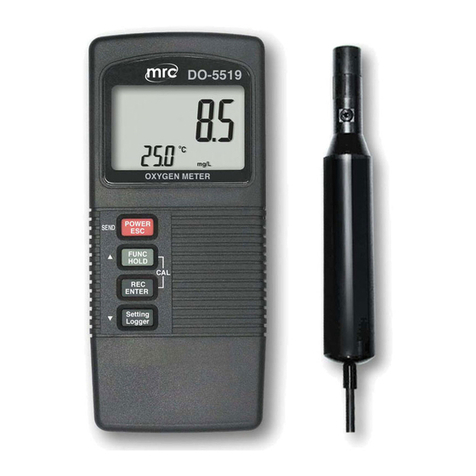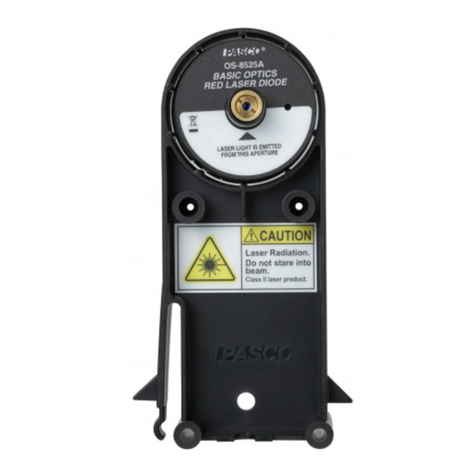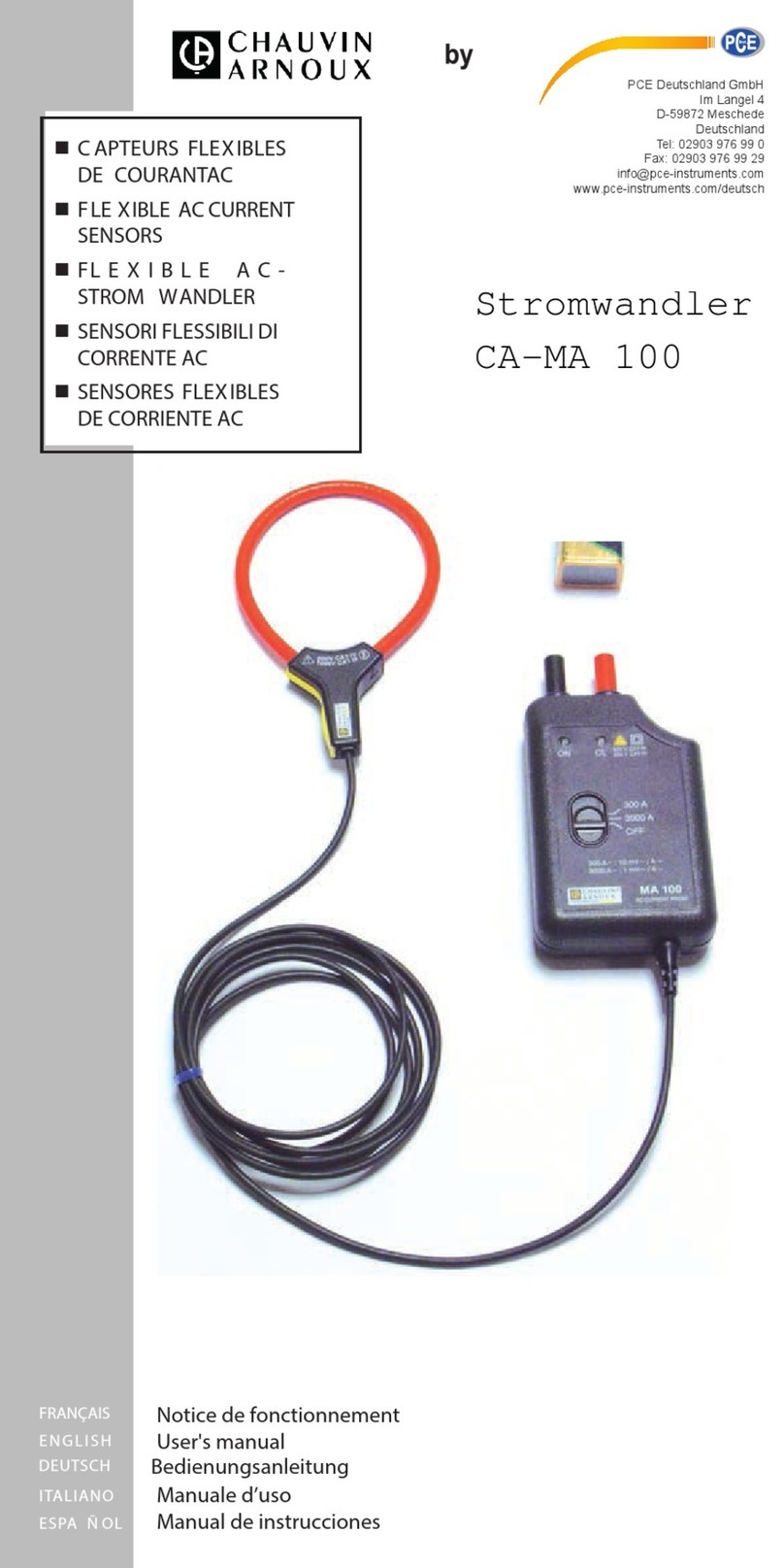Gilras GRK-6000 User manual

ser's
anua
Auto Ref/Keratometer GRK-8000
r
.,..,f,Cs
,
GRK-8000
)
•
•

Usage
precautions
Before
use
CAUTION
•
Do
not
use
th
e
device
for
other
than
the
intended
purpos
e.
We
are
not
respons
ible
for
acciden
ts
or
ma
l
functions
caused
by
careless
use.
•
Be
sure
to
read
the
manual
prior
to
operation
of
the
device
to
understand
the
safety
precautions
and
operat
ing
procedures
thoroughly
.
Us
ing
th
e
dev
i
ce
for
pur
poses
other
than
specified
in
this
manual
may
cause
unexpected
malfunct
i
ons
and
/
or
adve
r
se
events.
•
Never
disassemble
nor
touch
the
inside
of
the
device
.
This
may
resuIt in
electr
ic
shock
or
malfunct
i
on
.
•
In
sta
ll
th
e
device
in
an
environment
that
meets
the
following
conditions
.
The
following
cond
i
tions
must
be
maintained
during
use
.
Use
condit
i
ons
Temperature: 10
to
35°C
(50
to
95°F)
Humidity:
30
to
90
o/
o(N
on-condensing)
Pressure:
800
to
1060
hPa
A pl
ace
wit
h
low
dust
A pl
ace
wit
h
little
ex
terna
l
light
A
level
and
stable
su
r
face
free
from
vibration
and
shock
If
the
device
is
not
instal
led
and
used
unde
r
the
above
cond
i
tions
, the reli
ab
il
ity
of
measured
r
esults
is i
mpaired
,
and
malfunction may
resu
lt. In
addit
ion, th
ere
is a
possib
il
ity
of
injury
if
the
device
receives
shock
and falls
down.
•
Avoid
storing
the
device
where
it
is
exposed
to
ra
in
or
water
,
or
poisonous
gas
or
liquid
is
present.
Cor
r
os
i
on
or
malfunctio
n
of
the
device
may
occu
r.
•
Avoid
installing
the
device
where
it
is
exposed
to
direct
air-conditioning
flow
.
Changes
in t
emperature
may
result in
condensation
inside
the
device
or
adverse
ly
affect
measu
r
ements
.
•
Be
sure
to
use
a
(HOS
PITAL
GRADE)
wall
outlet
which
meets
the
power
specification
requirements
.
If
the
l
ine
voltage
is
too
high
or
too
low
,
the
dev
i
ce
may
not
per
form
properly.
Malfunction
or
fire
may
occur
.
•
Connect
the
power
plug
to
a
ground
outlet.
Or
connect
a
grounding
wire
to
a
ground
terminal.
Electric
shock
or
fire
may
occurin the event
of
device
malfunction
or power leakage.
•
Never
use
a
power
strip
or
extension
cab
le
to
supply
the
device
with
power.
The
elec
trical
safety
may
be
lowered.

CAUTION •
Do
not
use
a
power
cord
other
than
the
one
provided
.
Also
do
not
connect
the
provided
power
cord
to
any
other
device.
Fai
l
ure
or
fire
may
resu
lt.
•
Do
not
place
heavy
objects
on
the
power
cord.
The
damage
d p
owe
r
co
rd
may
cause
fire
or
elec
tric
shock.
•
Before
connecting
the
cable
,
turn
off
th
e
power
switch
and
disconnect
the
power
cord
from
the
outlet
.
Ma
l
func
t
ion
of
t
he
device
may
r
esult.
•
When
the
device
is
carried
,
two
persons
should
hold
it
at
t
he
f
ront
a
nd
the
back
(both
right
and
left
sides)
.
Avoid
lifting
by
the
forehead
rest
or
main
body
instead
hold
it
by
the
bottom
of
the
base.
If
only
one
person
carries
t
he
dev
i
ce
, or ar
eas
other
than
the b
ase
are
used
fo
r
lif
ting and
the
dev
i
ce
falls,
the
re
is
a
possibi
lit
y of in
ju
ry
or
malfun
ct
i
on.
• To
transport
the
de
vice
,
use
the
special
packing
materials
to
protect
the
device
from
impact
of
dropping.
Excess
i
ve
vi
b
ration
or i
mpac
t
to
the
device
may
ca
u
se
malfunction.
•
During
installation
and
operation
of
the
device
,
observe
the
following
instructions
about
EMC
(electromagnetic
compatibility)
:
Do
no
t
use
the
dev
ice
simultaneously
wi
th
othe
r el
ect
r
onic
equ
i
pmen
t to
avoid
e
lec
t
romagn
etic i
nt
erf
ere
nc
e w
it
h
the
operat
ion of
the
dev
ice.
Do
n
ot
use
the
device
nea
r, on,
or
unde
r ot
he
r
electronic
equi
p
ment
to
avo
id
elec
t
romagne
tic inte
rf
er
ence
w
it
h t
he
operat
ion
of
the
dev
i
ce.
Do
n
ot
use
t
he
device
in t
he
same
room
wi
th other equi
pment
such
as
life-support
equipme
nt
, other
eq
u
ipmen
t t
hat
has
ma
jor a
ff
ec
ts
on the life
of
the
pati
en
t
an
d
res
ults of tr
eatment,
or
ot
her
measurement
or
tr
eatme
nt
equ
i
pment
that
involves
small
el
ectric
cur
r
ent.
Do
n
ot
use
t
he
dev
i
ce
si
multaneo
u
sly
with
portab
le and
mobile
ra
d
io
frequency
comm
u
nica
t
ion
systems
because
it
may
have
an ad
verse
effecton operation
of
the
dev
i
ce.
Do
n
ot
use
ca
b
les
and
accesso
r
ies
that
are n
ot
spec
ifi
ed
for
t
he
device
because
that
may in
creas
e
th
e
emission
of
el
ect
r
omagne
t
ic
waves
fro
m the devi
ce
or
the
system
and
decrease
the
imm
u
nity
of
the
device
to
elec
t
romagnetic
disturbance.
•
The
Electromagnetic
Compatibility
Directive
sets
the
essential
requirements
for
electrical
and
electronic
equipment
that
may
disturb
,
or
be
disturbed
by

During use
CAU
TI
ON
other
equipment
.
Follow
the
guidance
in
the
tables
for
u
se
of
the
device
in
an
electromagnetic
env
i
ronment
.
•
Before
use
, p
erf
orm
visual
and
operation
checks
.
If
abnormal
conditions
are
encountered
,
stop
using
the
device
.
If
the device
is
used underabnormal conditions,
intended
results
may
not
occur
.
Also
une
x
pected
mal
f
unctions
or
health
hazards
may
occur
due
to
improper
measurement.
•
Before
treating
each
patient
,
clean
the
patient
's
contact
area
(ch
in
rest
and
foreh
ead
rest
) wi
th
clean
absorbent
cotton
or
gauze
dampened
with
rubbing
alcohol.
If
chinrest
paper
is
used, remove
one
piece
for
each
patient.
For
severe stains. \Yipe the area notwitha
dry
cloth butwith gauzedampened \Vith
alcohol.
•
Keep
the
measuring
window
free
of
fingerprint
s
and
dust.
Themeasurement
accuracy
may decreasesubstantially.
• In
th
e
event
of
s
moke
or
s
trange
odors
, i
mmedi
ately
turn
off
the
device
and
disconnect
the
power
plug
from
the
outlet.
After
you
are
sure
that
the
smoke
ha
s
stopped
,
then
contact
us
or
your
authorized
distributor.
Usage
of
the
device
under
such
abnormal
conditions
may
cause
f
ire
or
electric
shock. In
case
of
fire, use a
dry
chemical (ABC)extinguisherto extinguish the fire.
• I
mmediately
replace the power
cord
if
the
internal
wires
are
exposed,
the
dev
ice
turn
s on
or
off
when
the
power
cord
is
moved
,
or
the
cord
and/
or
plug
are
too
hot
to
be
held
w
it
h
hands
.
This may
result
in el
ectric
shock
or
fire.
In the
event
of
malfunction,
disconnect
thepowercord from the'vall outlet.
Never
touch the inside
of
t
he
device.
•
Never
press
on
the
LCD
with
a
hard
object
s
uch
as
a
ball-point
pen
.
Keep
magnetic
objects
away
from
the
LCD.
The device
may
bedamaged.
•
Do
not
operate
the
LCD
with
wet
hands
.
Water seeping
into
t
he
device may result in fa
ilure
of
the device.
•
There
may
be a
few
dead
or
constantly-
l
it
pixe
ls
in
your
LCD. Th
is
do
es
not
represent
failure
of
the
LCD;
This
is
due
to
the
structure
of
the
LCD.

CAUTION •
This
device
has
been
tested
and
found
to
comply
with
the
limits
for
medical
devices
to
the
IEC 60601-1-2: 2001/
am1:
2004,
and
Medical
Device
Directive
93
/42/EEC.
These
limits
are
designed
to
provide
reasonable
protection
against
harmful
interference
in a
standard
medical
installation.
This
device
generates
,
uses
and
can
radiate
radio
frequency
energy
and
,
if
not
installed
and
used
in
accordance
with
the
in
structions
,
may
cause
harmful
interference
to
other
devices
in
the
vicinity
.
H
owever
,
there
is
no
gua
rant
ee
that
interference
will
not
occur
in
a
particular
installation.
If
this
device
does
cause
harmful
interference
to
other
devices,
which
can
bedetermined
by
turning
the
device
off
andon,the user
is
encouraged
to
try
to
correct
the
interference
by
one
or
more
of
the
following
measures
:
If
this
device
does
cause
harmful
interference
to
other
devices
,
which
can
be
determined
by
turning
the
device
off
and
on
,
the
user
Is
encouraged
to
try
to
correct
the
interference
by
one
or
more
of
the
following
measures
:
Reorient
or
relocate t
he
receiving
device
.
Increase the
separa
t
ion
bel\
veen the
devices
.
Connect
the
device
to
an
outlet
on
a
circuit
different
from
that
to \vhich t
he
other
device(s)
are
connec
ted.
Consult
the manufact
urer
or
field
service
technician for help.
•
The
device
is
Class
A
(CISPR1
1
cla
ss
ification)
.
It
is
allowed
in
domestic
establishments
when
used
unde
r
ju
r
isdiction
of
a
health
care
professional.
•
Never
use
the
device
with
cab
les
or
accessories
other
than the
designated
ones.
Malfunct
ion
caused
by
i
mproper
electromagnetic
compatibility
(E
MC
)
charac
t
eris
tics mayresult.
•
Never
use
portable
or
mobile
radio
frequency
(RF)
devices
in
the
vicinity
of
this
device
.
Thesedevices
may
adverselyaffect medical electrical equipmentand malfunction
may
result.

After
use
CAUTION
•
This
device
uses
a
heat-sensit
i
ve
pri
n
ter
paper
.
To
keep
the
printed
data
for
a l
ong
period
of
time
,
make
copies
of
the
printouts.
The
paper
degrades
over
ti
me
and
the
printed
data
may
become
ill
egible.
• Wh
en
the
device
is
not
in
use
,
turn
off
the
power
switch
and
put
the
dustcover
over
the
device.
If
not,
dust
may
affect
the
measu
r
ement
accuracy.
• Do
not
yank
the
power
cord
to
di
sconnect
it
from
a
wall
outlet
but
ho
ld
the
plug.
This
can
damage
the
metal
core
of
t
he
cord
and
may
resu
lt
in fire,
short
ci
rcuit
or
electric
shock.
•
Occasionally
cl
ean
the
prongs
of
the
main
plug
with
a
dry
cl
oth.
If
dust
sett
les
between
the
prongs,
the
dust
will
co
lle
ct
mo
i
sture,
and
short
circuit
or
fire
may
occur.
• If
the
device
wi
ll
not
be
used
f
or
a l
ong
time
,
disconnect
the
powe
r
cord
from
the
wall
outlet.
Fire
may
occ
u
r.
•
Maintain
t
he
surrounding
temperature
and
humid
i
ty
in
the
fo
ll
owing
ra
n
ges
during
transport
and
storage
of
the
dev
i
ce.
Environmental
conditions
Temperature:
-10
to
55°C
(14
to
131°F)
Humid
it
y: 10
to
95o/o
(non
-c
ondensing)
Atmospheric
pressure:
700
to
1
060
hPa
A pl
ace
with
low
dust
A pl
ace
not
exposed
to
direct
sunl
i
ght
• Wh
en
transporting,
pack
the
main
body
in
the
original
packing
mater
i
al
with
the
fixing
leve
r un
locked.
Ex
cess
i
ve
vibrat
i
on
or
impact
may
cause
device
malfunct
i
on.

Maintenance
and
check
CAUTION •
Only
service
technicians
properly
trained
by
us
can
repair
the
device.
We
are
n
ot
re
sponsib
le
for
any
acc
i
de
nt
s r
es
u
lt
ed f
rom
i
mprop
er se
rvic
ing.
•
When
performing
maintenance
work
, se
cure
sufficient
maintenance
space.
Maint
e
nance
work
in an
insuffic
i
ent
space
may
result in inj
ury
.
•
When
the
device
is
sent
back
for
repair
or
maintenance
,
wipe
the
surfaces
(especially
,
the
area
where
patients
contact)
of
the
device
with
a
clean
cloth
dampened
with
ethyl
alcohol
for
disinfection.
Contact
us
or
your
authorized
distr
i
butor
to
check
whether
the
device
needs
measurement
accuracy
calibration
if
the
AR
-
measured
results
are
substantially
different
from
subjectively
measured
results
.

Table
of
Contents
1.
BEFORE
USE
........
.
..
.
..
.
......................
.
..
.
..
.
......................
.
.....
.
...............
.
....
.
....
.
...................
.
..
...
...
.1
1.1
Outline
of
the
Device
1
1.2 I
ntended
Use
1
1.
3
Princ
i
ples
1
1.4
Conf
i
guration
2
1.
5
Meas
urement
Screen
Layout
5
1.6
Checking
Contents
7
1.7
Before
First
Use
7
2.
OPERATING PROCEDURES
··················
····························
........................................
a
2
.1
Operat
ion
Flow
2.2
Preparation
for
Measurement
2.2.1 Sleep mode
2.2.2. Finish measurement
2.3
AR
(refractive
e
rr
or)
Meas
urements
2.4 KM
(corneal
curvature
rad
ius
)
Measurement.
(KER
Series
)
2.5
SIZE
Measurement.
(KER
Series
)
2.6
Print
ing
2.6.1 Pr
in
t
in
g measured data
2.6.2 Printing parameter settings
2.6.3 Replacing Prin
ter
Pa
per
2.7
Parameter
tables
2.8
Main
Paramete
r
tables
2.9
Sett
ing the
date
and
time
2.1
O Setting
the
company
8
8
11
11
12
13
13
14
14
15
16
17
17
18
3.
SPECIFICATIONS AND ACCESSORIES
.............................................................
13
3.
1
Specif
i
cat
ions
3.2
Standa
rd
Configu
r
ation
18
19

BEFORE
USE
1.1
Outline
of
the
Device
The
dev
i
ce
wh
i
ch
objec
ti
vely
measures
refractive
erro
rs
of
sphere
,
cy
l
inde
r,
and
axis.
Refract
i
on
is
ma
inly
performed
as
a
reference
for
lens
prescript
i
on
to
correct
the
visua
l
acu
it
y
usi
ng gl
asses
or
contact
len
ses.
This
device
is
a si
ng
le
unit
with
the
main
body
mounted
on a
base.
The
base
is
provided
with
a chinr
es
t
on
the
patient
si
de
and
an
LCD
panel
,
operating
bu
ttons,
joystick,
and
prin
ter
to
fac
il
itate
alig
n
ment
and
other
ope
r
ations.
The
device
offers
the
following
feat
u
res
in addi
tio
n
to
the
above
features:
•
The
device
is
provided
w
it
h
an
auto
track
i
ng
mecha
n
ism
that
achi
eves
al
ignmen
t in
the
up-and-down
direct
i
on
.
• An
auto
shot
funct
ion
is
prov
i
ded;
measuremen
ts
to
be
taken
au
tomatically
when
the
dev
i
ce
is
best
aligned
and
in
focus
.
• A
motorize
d
up
-
and
-
down
chi
nrest
allows
the
operato
r
to
easily
adjus
t the h
eight
of
t
he
chin
res
t.
•
Printer
h
as
a
paper
auto-c
ut
f
eature
.
1.2
Intended
Use
The
Au
to
Re
fr
act
o
me
t
er
is
a di
agnostic
device
tha
t
is
indicated
for
use
in the
automated
measurement
of
refract
i
ve
errors
of
the
eye
.
Th
e
Auto-Re
f/
Keratometer
is
a
medica
l
app
l
iance
whic
h
performs
measurement
of
the
refract
i
ve
errors
of
the
eye
and
co
r
neal
radius
of
curvature.
1.3
Principles
Fi
ne
meas
u
rement
beams
are
pr
ojected
on
the
fund
us
of
the
pat
ient
's
eye
by
a
projecting
opt
ical
system
and
th
en
computation
is
pe
r
formed
by
captu
ring the
reflected
beams
as
a
r
ing
image
to
measu
re the
refract
i
ve
errors
(SPH,
CYL
,
and
AX
IS)
of
the
patient's
eye.
1

1.4
Configuration
2
Fr
ont vi
ew
1, Function
buttons
2.
LCD
3.
Power
Light
4.
Measure
button
6.
Locking
lever
7.
Power
switch
8.
Printer
cover
9.
Cover
open button
1.Function
buttons
Set
the
device
and switch the screen.
Functions
assi
gned
to
the function buttons are di
splayed
by
icons
on
the
screen.
Two
buttons
in
the
lower
left
corner
of
the
screen
have
unique
functions
when
the
measurement
screen is
displayed.
•
Clear
button (
''
)
Erases
measured
data.
When the
clear
button is held
for
about
a
second
, all
the
measured
data
is
erased.
•
Print
button
(
~
)
Pressing
this
button can
print
out
the
measured data.
2.
LCD
5.7-inch
LCD.
Pul
ling
the
bottom
of
the
disp
l
ay
panel
provides
an
adjustab
le
viewing angle.

For
measurementin a standing posture, set the panel
at
a suitable angle. Thepanel isresetto
its origin
al
position
by
magnet.
3.
Power
Light
The
power
light
is
on,
indica
ting
that
the devi
ce
powers
on
proper
ly.
4. Measure
button
When the
measure
button
is
pressed,
measurement
is
taken
regard
l
ess
of
the
alignment
or
focusing
cond
it
ion
of
the
device.
5.
Joystick
Used for ali
gnment
and focusing.
Alignment
in
the
right
and l
eft
directions
can be performed by moving thejoystick to the right
and left.
Rotating
the
joystick
is
fo
r ali
gnment
in
the
up
and down
direct
i
ons.
For
focusing,
move the
joystick
forward
and backward.
6. Locking
lever
Secures
the main
body
to the
base
.
To
l
ock
the
main
body
, press
the
l
ocking
lever
down.
7.
Power
switch
Turns on the
power
to
the
device
.
8.
Printer
cover
Protects a
printer
equipped with an autocutter. Open the
printer
coverto replace printerpaper
by
pressing
the
cover
open
button.
9.
Cover
open
button
Opens
the
printer
cover
.•
Rear
view
10
.
For
ehead rest 13. Eye
leve
l
marke
r
11.
Measuring
--+,~--'"
-'i
window
14. Chinrestup/down button
3

4
10.
Forehead
r
est
During
measu
r
ement
, the
patient's
forehead
shou
ld
be
gent
ly
res
t
aga
i
nst
the
forehead
rest.Clean
the
chin
rest
for
each
patient.
11
.
Measuring
window
Check
the
window
clean
li
ness
before
measu
r
ement.
12.
Chinrest
Clean
the chinr
est
for
each
pat
i
ent.
13.
Eye
level
marker
Used
as
a
guide
for
the
patient's
eye
l
evel
during
measurement.
The
height
of
t
he
ch
i
nrest
should
be
adj
u
sted
so
that
t
he
center
l
evel
of
t
he
patient
's
eye
roughly
ali
gns
wi
th
this
l
ine
.
14
.
Chi
n
rest
up
/
down
button
Moves
the
chin
rest
up
or
down
.
15
.
PD
window
An
LED
is
provided
to
detect
the PD
value.
Underside
view
- -
•
•
16.
Power
i
nlet
Adetachable
power
cord
is
co
n
nected
here
.
16.
Power
i
nlet

1.5
Measurement
Screen
Layout
19.Auto
20.
Auto
1.
Pat
ie
nt
's eye
2.
Reset
button
3.
Fundus
circle
---+-
--"'-
-t--
17.
Measure
mode
18.
VD
VD
--,
,'
...
16.
CYL
mode
15. Focusing indi
cator
14. Menu
button
13.
Measuring
wi
ndow
4.
Circle
display
--1---1
button
5. Chi
nrest
limit
, I
ff
\
f'
I ,
\ /
,,
,
...
....
__
...
lim
it
~
12.
Measure
mode
button
...
6.
Auto
track
ing
-----
·
button
7. H
istory
button
8.
Measured
va
l
ues
1.
Pat
i
ent's
eye
1
s -4.50
c
-0.
50
A 69
R 2
R1
7.62
R2
7.62
AA
0
pl
9. PD
Indicates
the
right
or
left
eye
of
the
patient.
2.
Reset
button
(
''
)
Rest
the
device
to ini
tia
l state.
3.
Fundus
circle
L 2
s -5.25
c -
0.75
A 147
10.
Print
button
After
a
measurement,
you
can
observe
the
stored
ret
ina
image
by
pressing
the
circle
display
key
.
If
the
i
mage
is
an
i
ncomplete
circ
le,
the
measurement
is n
ot
re
li
ab
l
e,
and should be
made
once
again. I
ncomp
l
ete
retina i
mages
may
be
caused
by eye
blink
ing
or
by
eye
movement.
Sometimes
it
is
beca
u
se
the
signal
reflected
from
the
retina
is
too
weak,
or
the
pupi
l
diameter
is
less
than
2.0mm,
or
the
dust
in
the
surface
of
the
lens.
4.
Circ
le di
sp
l
ay
button
Afte
r
pressing
measu
r
ement
key, a
window
will
popup
on
the
left
upper
LCD, Eyegr
oud
parameter
im
age
cycle
measured
by
i
nstrument
disp
l
ays
,
which
is
used
to
judge
the
valid
it
y
of
measurement
.Press
ing
the
key again ,
it
will
close
the
window.
5. Chin
rest
limit
When
the
chin
rest
is
at
the
upper
(or
lowe
r)
mechanica
l
lim
it,
the
uppe
r l
imit
ind
i
cator
(
~
)or
lower
limit
indicator(
~
) is
displayed
on
the
screen.
5

6
6.
Auto
tracking
button
Se
l
ects
the
auto
tracking
function.
7.
History
button
Show
the
all
measurements
8.
Measured
values
Displays
the
la
test
measured
results
.
9
PD
10.
Print
button
Print
the
measured
results
11.CYL
mode
button
Switches
cy
l
inder
mode.
CYL-
Indi
cates
cyl
i
ndr
i
ca
l
power
by -reading.
CYL+
In
dicates
cylindrical
power
by+
readi
ng
.
CYL
+ Cyl
inder
data
is i
ndicated
by+
reading
when
the
refractive
error
is
positive
for
any
axis
angle.
I
ndicates
the
cylindrical
power
by
-reading in
other
cases
.
Cylinder
mode
can
be
switched
even
after
measurement.
Data
is
printed
out
with
the
mode
status
at
the
time
of
printing.
12.
Measure
mode
button
(KER
Ser
ies)
Select
the
mode
of
REF
.
KER
. R&K .
SIZE
.
13.
Measuring
window
limit
When
the
measuring
window
at
the
upper
(or
lower)
mechanica
l li
mit,
the
uppe
r
lim
it
indicato
r ( ; )
or
lower
limit
i
nd
i
cator
(
~
)is
displayed
on
the
screen
.
y A
14.
Menu
button
Set
parameters
,
date
and
time,
and
enter
comments.
15
.
Focusing
indicato
r
I
ndicates
the di
stance
between
the
ma
in
body
and
the
patient's
eye.
Operate
the
joystick
unti
l t
he
optimum
condition
is di
splayed.
16
.
CYL
mode
Represents
the
se
l
ected
cylinder
mode.
17
.
Measure
mode
Represents
the
selected
cylinder
mode.
18
. VD
Represents
the
se
l
ected
VD
value.

19.
Auto
measure
icon
Represents
the
setting
of
the
auto
measure
function.
20.
Auto
tr
ac
k
ing
ic
on
Represents
the
setting
of
the
auto
tracking
funct
i
on
(alignment
in
the
up
,
down
directions).
1.6
Checking
Contents
Unpack
the
contents
from
the
shipping
carton
and
check
them.
The
fol
lowing
are
included
in the
standard
conf
i
guration.
·Ma
in
body
•Printer
paper
(2
rolls)
•Power
cord
·Dust
cover
•Operator's
manual
(this
book)
•Model
eye
1.7 Be
for
e
First
Use
Place
the
device
on a
stab
le
table
and
connect
the
power
cord.
1 Pl
ace
the
main
body
to
a
stable
table.
2
Lock
the
main
body
to
the
base
unit
with
the
locking
lever
and
lay
the
device
down
gently.
3
Connect
the
power
cord
to
the
power
inlet.
4
Stand
the
device
upright.
5
Confirm
that
the
power
switch
is
turned
OFF
and
pl
ug
the
power
cord
into
a
wall
outlet
(Be
sure
to
use
an
outlet
equipped
with
a
ground
terminal
, El
ectric
shock
or
fire
may
occur
in
the
event
of
device
malfunction
or
power
leakage).
6 Turn
ON
the
power
switch.
The
initial
screen
is
displayed
on the
LCD
and
the
device
starts
initializing.
7
Conf
irm
that
the
measurement
screen
is di
sp
l
ayed.
8
Load
the
printer
paper.
7

]
OPERATING
PROCEDURES
2.1
Operation
Flow
Power
ON
Measurement
Printing
Power
off
•
2.2 P
reparation
for
Measurement
Turn on the
power
switch and
set
measurement
conditions
if
necessary.
Pr
epare
the
pat
i
ent
.
2.3
AR
(refract
ive
error)
Measurements
2.4 KM
(co
rneal
curvature
r
adius)
Measurement.
(KER Ser
ies)
2.5
SIZE
Measurement.
(
KER
Series
)
2.6 Pr
int
ing
2.2.3
Fin
ishing
the
measurement
*
For
lens
presc
ri
ption
for
correction
of
visual
acuity
of
gl
asses
or
such
,
subject
ively
test
the
pat
i
ent's
visual
acuity
with
reference
to
AR-measured
data.
2.2
Preparation
for
Measurement
1 T
urn
on
the
power
switch
.
8

The in
it
ia
l
sc
reen
is
displayed
and the
device
is
in
it
ia
liz
ed.
AUTO
Re
fractometer
Cc
pyr
l
ghl
20
11.
2012
Ve
r
1.7
1
AutoRefraclometer
Ini
tia
l
sc
reen (REF)
AUTO
Ref/Keratometer
Auto
Ref
&
Keratom
e
ter
Copyrlght
20
1t·2012Ver 1.
21
Init
i
al
screen (REF/ KER)
Wait for a
while
unt
il
the
screen
is
sw
i
tched
to
the
measurement
screen.
When the
power
to
the
device
is
turned
on
,t
he
main
b
ody
makes
small right/left
movemen
ts in
order
to determine
the
initial
setting
position
for
auto
trac
ki
ng.
Thi
s
does
not
mean
that
the
device
has
bee
n
broke
n.
2 The
measurement
screen is di
splayed
.
!Bl
,,
0
•
•A•
• R
• s o.
oo
c 0.00
,..-+
···
··
..
,
. .
~
;
"·
.....
·
A 0
PO
-
0
CV\.
L
s 0.00
....
c 0.00
A 0
Measu
rement
screen
3 Perform
checks
b
efore
use
Perform the
follow
ing ch
ecks
before
use.
No
error
message
is
displayed
.
The main body
moves
smoothly
using
the j
oyst
ick.
The chinr
est
moves
up
and d
ow
n by
press
ing
the
chinres
t
up
/down button.
Pr
i
nte
r
supp
ly is
adequate.
The
measurement
accuracy
satisfies the
spec
i
fications
.
4
Estab
li
sh
measur
ement
conditions
.
The
follow
ing condi
tions
should
be specified:
..
..
.
.
.
. .
..
...
...
+
......
No F
ocus
F
ocus
.
.
.
.
.
.
9

10
1:
Meas
ure mode
Presstheauto
track
i
ng
button
to
selectautotrackingandselecttheauto measure on the menu.
Auto Auto Screen Description
tracking measure display
m
Auto
tracking
in the
up-and-down
directions
is
t
urned
on.
Manual
ly
ON
alignthedevicein the left-
and
-right.Measurementstartsautomatically
~
Up
and
when the eye
is
best
aligned
and
focused.
Down
m
Auto
tracking
in the
up-and-down
directions
is
turned
on.Manually
OFF
align the
dev
ice
in
the
le
ft
-and-
right
and
bring the eye i
nto
focus.
[
OFF)
Press the
measure
button
to
start
measurement.
w
Manually
al
ign
the
device
and
bring
theeye
into
focus.
ON
Measurement
starts
automatically
when
the eye is
best
al
igned
~
and
focused.
OF
F
OFF
w Manually al
ign
the
dev
ice
and
bring
theeye
into
focus
.
[O
FF)
Press the
measure
button
to
start
measurement.
2:
Measu
r
ement
conditions
set
by
parameters
Various
dev
i
ce
conditions
ca
n
be
set
by
par
amete
rs.
3: CYL
mode
The
cylinder
mode, reading direction
of
cylinderdata in which
cylinder
data
(cylindricalpower)
is
represented
during
measurement
is
se
l
ected
by
pressing
the
CYL
mode
button
.
Scr
een
displ
ay
CYLmode
Description
C
YL-
-readi
ng
In
dicates
cylindrical
power
by+
reading.
CYL+
+read
i
ng
I
ndicates
cylindrical
power
by
-
reading.
Cyli
n
de
r
data
is
indica
ted
by+
readi
ng
whe
n the
CY
L ±
Mi
x r
eading
refractive
error is
pos
i
tive
for
any
axis
angle.
Indi
cates
the
cylindr
ical
power
by -
reading
in
other
cases.
5
Prepare
the
patient
_
1)
Wi
pe
the forehead rest and chinrest that
contact
the
patient
with
clean
absorbent
cotton
or
gauze
dampened
with
rubbi
ng
alcohol.
If
a stack
of
chinrestpaperisfixed
on the
ch
inrest, removeonesheet
of
paper.
Chinres
t
--
-'<;"\""~
~
2)
Instruct
the
patient
to
take
off
glasses
or
contact
lenses
and
sit on a
cha
i
r.

3)
Have
the
patie
nt
place
his/her
chin
on
the
chin
rest
as
deeply
as
poss
ible
,
and
hi
s/her
forehead
on
the
forehead
rest
lightly.
4)
Adjust
the
height
of
t
he
chi
nrest
by
pressing the chin
rest
up/down
button until the
cente
r
level
of
the
patient's
eye
aligns
with
the
eye
leve
l
marke
r.
Before
adjusting
the height
of
the chinrest, let
the
patient
know
that
the chin
rest
moves
up
and
down.
When t
he
ch
i
nrest
is
at
t
he
up
per
(or
lower)
mechanica
l limit, the
upper
limit
indicato
r
(or
lower
lim
it
indicator)
is
displayed
on
the
sc
reen.
6
Start
me
asu
reme
nt.
See
"2.3
AR
(ref
r
active
error)
Measurements"
for
details
of
measure
ments
.
I
nstruct
the
patient
not
to
b
link
d
uring
measurement.
Additiona
l
ly
,
instruc
t the
pat
i
ent
not
to
blink
or
open hi
s/her
eyes
I
mmediately
before measu
rement
to
avoid
measurement
fail
ure
.
I
ns
t
ruct
the
patient
to
keep
both
eyes
wide
open during
measurement.
Closing
one
eye
may
cause
an
uns
tab
le
fi
xat
ion
and
the
other
eye
may
not
open
wide.
7
Print
the
measured
results.
Printing
operat
ion
var
i
es
accord
ing
to
the
parameter
setting.
2.2.1
Sleep
mode
The
device
goes
into
sl
eep
mode
automatically
to
save
power
if
no
operat
ion is
performed
for
a
certa
in
period
of
time. The ti
me
that
the
device
goes
into sl
eep
mode
can
be
se
l
ected
from
5
minutes,
15
min
ut
es
,
or
NO
(no
sl
eep
mode)
(facto
ry
sett
ing: 5
min
ut
es).
Sleep
mode
pl
aces
the
dev
i
ce
i
nto
the
following
condit
i
ons:
• The
LCD
goes
off.
The
working
status
LED blinks.
•
LCD
has
been in screen
protection
always
The
work
ing
status
LED blinks.
The
device
recovers
to
normal
mode
from
sleep
mode
by
the
following
methods:
· Pr
ess
any
button.
·Manipul
ate
the
joyst
ick
to
move
the
base
R
or
L.
2.2.2
Finishing
the
measurement
1
To
finish
the
measureme
nt, t
urn
off
the
powe
r switch.
It
is
allowed
to
turn
off
the
power
w
it
h
any
sc
r
een
displayed.
2
Check
the
measur
ing
window
and
cl
ean
the
lens
if
necessa
ry.
3 Cl
ea
n the
forehead
rest
and
chinrest,
and
put
the
supplied
dust
cover
on
the
device.
Al
ways
keep
them
clean
for
the n
ext
use.
11

2.3
AR
(refractive
error)
Measurements
12
1
Instruct
the
patient
to:
"
Look
through
the
measuring
window
.
As
you
will
see
the
picture
,
watch
the
c
enter
of
it
without
straining
''.
2
Manipulate
the
joystick
to
display
the
patient
's
eye
on
the
screen.
By
mov
i
ng
the j
oys
tick
laterally,
the
main
body
moves
ri
ght,
lef
t,
forward
and
backwa
rd.
By
turni
ng
the
upper
part
of
the
joyst
i
ck
,
the
main
body
moves
up
and
down.
Align the
eye
posi
tion to
the
measur
i
ng
po
i
nt
wi
th
r
igh
t,
lef
t, up
and
do
wn
move
ments.Adj
ust
the focus
w
it
h
forward
and
backwa
rd
movements
.
3
Perform
alignment
and
focusing
The
methods
of
ali
gnment
and
focusing
vary
according
to
the
sett
i
ngs
of
the
auto
trac
king
and
auto
sho
t.
Up-and-down
auto
tracking
1)
Per
form
rou
gh
al
ignment
and
focus
i
ng
by
mani
pul
a
tin
g
th
e
joystic
k
to
place
in the
worki
ng r
ange
of
a
uto
tr
ac
k
ing
.
2)
When
the
dev
i
ce
is pl
aced
wi
t
hin
the
wo
rki
ng
range
of
auto
t
rack
i
ng
,
it
automa
ti
cally
starts
alignm
e
nt
in
the
up
-
and
-
down
direct
i
on.
3)
Manipulate
the
j
oystick
to
move
the
mire
ring
reflected
on
the
pat
ient's
eye
with
in the
tar
get.
Auto
track
i
ng
OFF
1)
Mani
p
ula
te
the
j
oys
tick
to
pe
rf
orm
rough
align
me
nt
a
nd
focu
si
ng.
2)
As
the
f
oc
u
sing
indicator
is
di
sp
l
ayed,
manipulate
the
j
oys
ti
ck
until
the
optimum
focus
ing indi
ca
t
or
is
displaye
d.
During
t
he
foc
u
si
ng,
ma
int
ain ali
gnme
nt
betwee
n
the
device
and
the
patient's
eye.
When
main
body
is
not
within
the
working
range
of
auto
tracking
:
As
t
he
limit
ind
icato
r is displ
ayed
,
mani
pul
ate
the
j
oys
ti
ck
or c
hinr
es
t
up/
d
ow
n bu
tt
on
in
t
he
di
r
ect
i
on
of the
arrows
.
Move
the chin
res
t
up.
Move
the chin
res
t
down.
4
Measurement
starts
.
Measur
e
ments
are
ta
ken a
ut
omat
i
ca
lly
whe
n t
he
device
is
bes
t
al
i
gned
and
focuse
d
on
the
eye (when t
he
auto
measur
e fu
nct
i
on
is turned
on)
.
When
the
auto
measure
function
is
turned
of
f,
press
the
start
button
to sta
rt
measurement
5
Measurement
completes.
When
the sp
ecified
num
ber
of
AR
measu
r
ements
is
pe
rf
ormed
and the
data
is st
able
(no.
Table of contents
Other Gilras Measuring Instrument manuals
Popular Measuring Instrument manuals by other brands
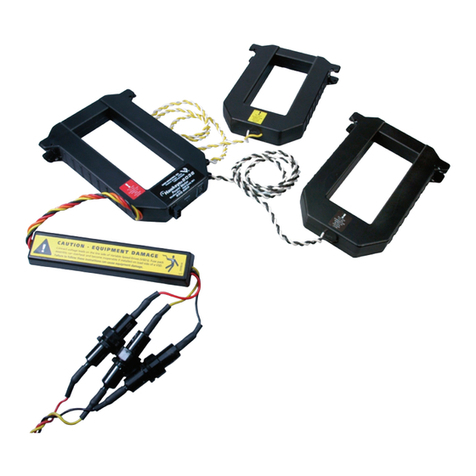
Veris Industries
Veris Industries ENERCEPT H8051 Series installation guide
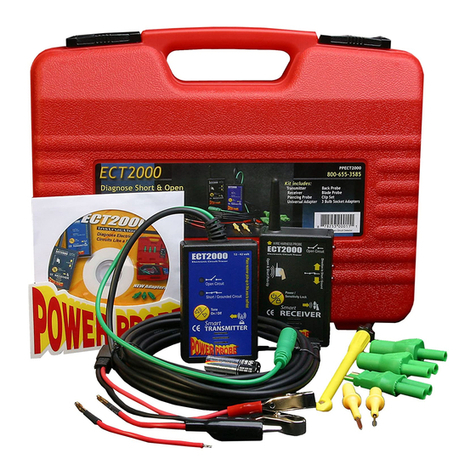
Power Probe
Power Probe power probe III ECT-2000 instruction manual
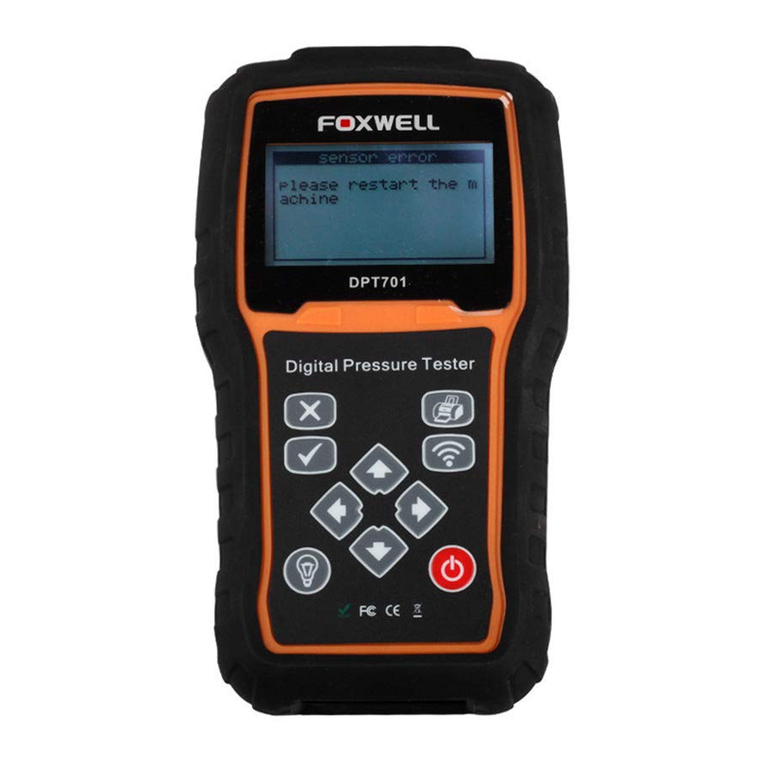
Foxwell
Foxwell DPT701 user manual
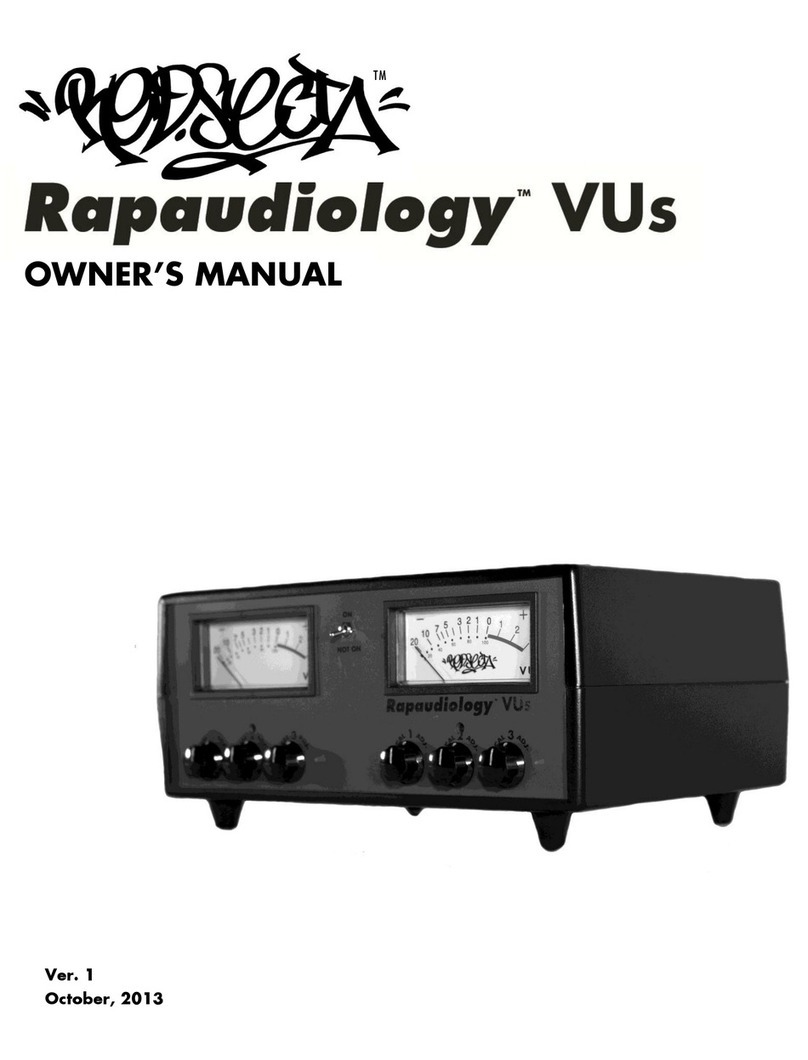
Redsecta
Redsecta Rapaudiology owner's manual
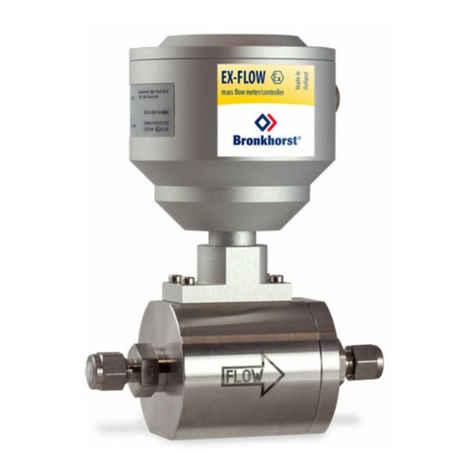
BRONKHORST
BRONKHORST F-112AX instruction manual

Keithley
Keithley 3390 Adjustment manual
